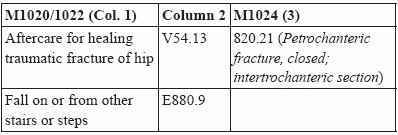Pave the Way for ICD-10 Fracture Coding Changes
When it comes to ICD-10-CM coding, fractures are one of the areas where you’ll see the biggest difference compared to ICD-9-CM. But you can master the changes with ease if you start preparing now.
Say Goodbye to Aftercare Codes for Injuries
The biggest change you’ll see in coding for injuries such as fractures under ICD-10-CM is that you’ll no longer list aftercare codes like V54.13 (Aftercare for healing traumatic fracture of hip). Because home health doesn’t treat the acute injury but instead provides aftercare, coders have long been listing aftercare codes for patients with fractures.
But under ICD-10-CM, you’ll code for the injury with the appropriate seventh character instead, says Ann Zeisset, RHIT, CCS, CCS-P, AHIMA-Approved ICD-10-CM/PCS Trainer with Ann Zeisset Consulting in Trenton, Ill.
ICD-10-CM Coding Guideline I.C.19.a. states: "The aftercare Z codes should not be used for aftercare for conditions such as injuries or poisonings, where 7th characters are provided to identify subsequent care." It is interesting to note that the rehabilitation codes (such as ICD-9-CM V57.1, Other physical therapy) are included in this new change, Zeisset says. There is no longer a category for care involving rehabilitation in ICD-10-CM
For fractures, the array of seventh characters varies by fracture type. As an example, the seventh characters you can choose from for closed fractures for S72.00- (Traumatic fracture of neck of femur) include
A — initial encounter for closed fracture
D — subsequent encounter for closed fracture with routine healing
G — subsequent encounter for closed fracture with delayed healing
K — subsequent encounter for closed fracture with nonunion
P — subsequent encounter for closed fracture with malunion
S — sequela of fracture
So, for a patient with a traumatic fracture of the right hip with routine healing, under ICD-10-CM you would report S72.001D (Fracture of unspecified part of neck of right femur; subsequent encounter for closed fracture with routine healing).
More detail: There is an expansion in the 7th characters for certain fractures of the long bones (such as the femur) to identify open fractures and classify the amount of trauma involved, Zeisset says.
Don’t miss: The concept of coding the fracture and not aftercare is also applied to pathological fractures found in the musculoskeletal chapter.
Coding scenario: Your 76 year-old patient is admitted after a displaced intertrochanteric left hip fracture due to a fall down the steps. The fracture is healing normally.
In ICD-9-CM you would code for this patient as follows, says Brandi Whitemyer, RN, COS-C, HCS-D, HCS-O, AHIMA Approved ICD-10 Trainer/Ambassador in Weslaco, Texas:
And in ICD-10-CM, under OASIS-C1, you would code for this patient as follows, Whitemyer says:
With ICD-10-CM’s increased specificity, you can capture both the laterality of the fracture, as well as the healing status, Whitemyer says. In addition, the displacement and the encounter are integral to the code.
Take note: In the ICD-10-CM coding example, you don’t need to list an aftercare code for this patient. Instead, you’ll list the fracture code in M1021, which takes the place of M1020 in OASIS-C1.
In both ICD-9-CM and ICD-10-CM for home health, the external cause for the fall is optional.
OASIS changes: The OASIS-C1 draft version has been released and now includes a column with the item number M1025, Whitemyer says. CMS explains that M1025 will not be used for payment, but instead for risk adjustment. The directions for M1025 ask for any unresolved conditions to be reported in this column, Whitemyer says. "This is different than our current guidance for M1024."
As is true in the sample scenario, M1025 would not be used for fractures because there would be no Z code used in the place of the fracture code, Whitemyer says.
Expect a Change in Complications
Under ICD-9-CM, when you’re caring for a complication of a fracture like a nonunion or malunion, you don’t list an aftercare code. Instead, you’ll report the diagnosis as a late effect with a code to indicate the condition produced (nonunion — 733.82 or a malunion — 733.81) followed by category 905 (Late effects of musculoskeletal and connective tissue injuries) code. For example, you might list 905.4 (Late effect of fracture of lower extremities) which clarifies that a condition is a late effect of a fracture and specifies the site of the break.
In ICD-10-CM, you would once again report the acute fracture code for these complicated fractures, with the appropriate seventh character. For example, S82.892K (Other fracture of left lower leg; subsequent encounter for closed fracture with nonunion). But rather than reporting nonunions and malunions as late effects, in ICD-10-CM you’ll report them as subsequent encounters.
Work Out Documentation Issues Ahead of Time
The expansion of information included in ICD-10-CM codes gives you an opportunity to be even more specific about the fractures you report. Location details, laterality, complications, and types of fractures have all been further detailed in the new code set.
For that reason, it’s a good idea to start working on improved fracture documentation now, Zeisset says. Work with physicians before the Oct. 1, 2014 implementation date to make sure you’re getting the information you need to assign the most accurate code, she says. 


